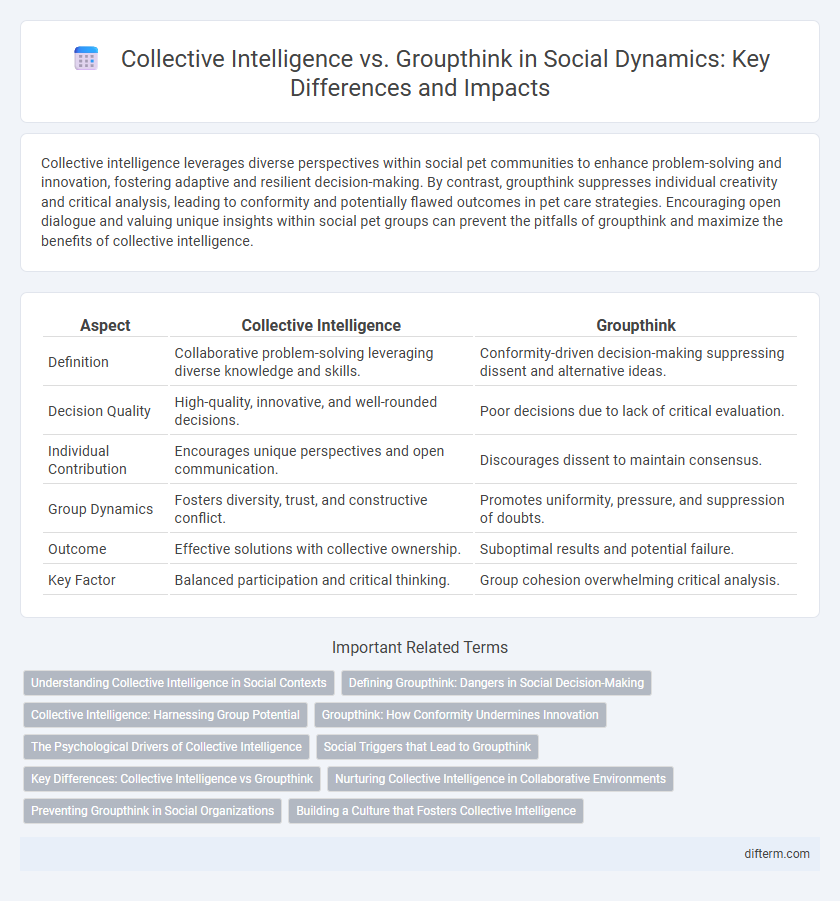Collective intelligence leverages diverse perspectives within social pet communities to enhance problem-solving and innovation, fostering adaptive and resilient decision-making. By contrast, groupthink suppresses individual creativity and critical analysis, leading to conformity and potentially flawed outcomes in pet care strategies. Encouraging open dialogue and valuing unique insights within social pet groups can prevent the pitfalls of groupthink and maximize the benefits of collective intelligence.
Table of Comparison
| Aspect | Collective Intelligence | Groupthink |
|---|---|---|
| Definition | Collaborative problem-solving leveraging diverse knowledge and skills. | Conformity-driven decision-making suppressing dissent and alternative ideas. |
| Decision Quality | High-quality, innovative, and well-rounded decisions. | Poor decisions due to lack of critical evaluation. |
| Individual Contribution | Encourages unique perspectives and open communication. | Discourages dissent to maintain consensus. |
| Group Dynamics | Fosters diversity, trust, and constructive conflict. | Promotes uniformity, pressure, and suppression of doubts. |
| Outcome | Effective solutions with collective ownership. | Suboptimal results and potential failure. |
| Key Factor | Balanced participation and critical thinking. | Group cohesion overwhelming critical analysis. |
Understanding Collective Intelligence in Social Contexts
Collective intelligence in social contexts emerges when diverse individuals contribute unique perspectives and knowledge, fostering innovative problem-solving and adaptive decision-making. This dynamic contrasts with groupthink, where conformity and pressure for consensus often suppress critical thinking and reduce overall creativity. Harnessing collective intelligence involves promoting open dialogue, valuing dissenting opinions, and leveraging varied cognitive resources to enhance group outcomes.
Defining Groupthink: Dangers in Social Decision-Making
Groupthink occurs when a cohesive group prioritizes consensus over critical evaluation, leading to flawed social decision-making and suppressed dissent. This phenomenon undermines collective intelligence by promoting conformity and reducing diverse perspectives essential for accurate problem-solving. The dangers of groupthink include poor risk assessment, overlooked alternatives, and ultimately, decisions that may harm the group's social and organizational outcomes.
Collective Intelligence: Harnessing Group Potential
Collective intelligence leverages diverse perspectives and skills within a group to solve complex problems more effectively than individuals working alone. By promoting open communication and collaboration, it enhances creativity and innovation, avoiding the pitfalls of conformity seen in groupthink. Harnessing this dynamic enables organizations and communities to make smarter decisions and adapt rapidly to changing environments.
Groupthink: How Conformity Undermines Innovation
Groupthink stifles innovation by promoting conformity and discouraging dissenting ideas within social groups. This phenomenon occurs when the desire for harmony overrides critical thinking, leading to suboptimal decision-making and the suppression of creative solutions. Organizations seeking innovation must actively cultivate diverse perspectives and encourage constructive debate to counteract groupthink's detrimental effects.
The Psychological Drivers of Collective Intelligence
Collective intelligence emerges from diverse cognitive contributions, fostering adaptive problem-solving and innovation within groups. Psychological drivers such as cognitive diversity, open communication, and mutual respect enhance information processing and decision-making effectiveness. Unlike groupthink, which stems from conformity pressure and limited critical evaluation, collective intelligence thrives on inclusive dialogue and balanced dissent.
Social Triggers that Lead to Groupthink
Social triggers that lead to groupthink include strong conformity pressure, high group cohesiveness, and the presence of a dominant leader discouraging dissent. When members prioritize harmony over critical evaluation, the desire to maintain unanimity suppresses alternative viewpoints, resulting in flawed decision-making. These dynamics undermine collective intelligence by inhibiting diverse perspectives essential for innovative problem-solving.
Key Differences: Collective Intelligence vs Groupthink
Collective intelligence harnesses diverse perspectives to enhance problem-solving and innovation, while groupthink suppresses dissenting opinions, leading to poor decision-making. Collective intelligence encourages open dialogue and critical analysis, promoting adaptive and effective outcomes. Groupthink prioritizes conformity and cohesiveness, often resulting in irrational or dysfunctional decisions.
Nurturing Collective Intelligence in Collaborative Environments
Nurturing collective intelligence in collaborative environments requires fostering diverse perspectives and encouraging open dialogue to avoid the pitfalls of groupthink. Implementing structured brainstorming sessions and promoting psychological safety enhance idea sharing and critical thinking. Tools like collaborative platforms and feedback loops support the dynamic exchange of knowledge, driving innovation and informed decision-making.
Preventing Groupthink in Social Organizations
Preventing groupthink in social organizations requires fostering an environment where diverse perspectives are actively encouraged and critical thinking is prioritized. Techniques such as appointing a devil's advocate, promoting open dialogue, and ensuring decision-making processes are transparent can mitigate conformity pressures. Emphasizing collective intelligence harnesses the varied expertise within the group, leading to more innovative and robust solutions.
Building a Culture that Fosters Collective Intelligence
Building a culture that fosters collective intelligence requires encouraging diverse perspectives and open communication to prevent the pitfalls of groupthink. Emphasizing psychological safety enables team members to share ideas freely, leading to more innovative and effective problem-solving. Organizations that prioritize collaboration and trust create an environment where collective intelligence thrives, driving better decision-making and adaptability.
collective intelligence vs groupthink Infographic

 difterm.com
difterm.com